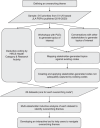Overarching Priorities for Health and Care Research in the United Kingdom: A Coproduced Synthesis of James Lind Alliance 'Top 10s'
- PMID: 38895996
- PMCID: PMC11187853
- DOI: 10.1111/hex.14096
Overarching Priorities for Health and Care Research in the United Kingdom: A Coproduced Synthesis of James Lind Alliance 'Top 10s'
Abstract
Introduction: James Lind Alliance (JLA) Priority Setting Partnerships (PSPs) produce 'Top 10' lists of health and care research priorities through a structured, shared decision-making process with patients or service users, carers and health or care professionals who identify questions that are most important to them. To date, over 150 PSPs in different areas of health and care have published research priorities. Some PSPs share similar priorities, which could be combined, promoted and addressed through collaborative research to increase value and reduce research waste.
Aim: The aim of this study was to identify overarching themes common to JLA PSP priorities across different areas of health and care.
Methods: Our analysis included 'Top 10' research priorities produced by UK-based JLA PSPs between 2016 and 2020. The priorities were coded deductively by the Health Research Classification System (HRCS) health category and research activity. We then carried out online workshops with patients, service users and carers to generate new codes not already captured by this framework. Within each code, multistakeholder inductive thematic analysis was used to identify overarching themes, defined as encompassing priorities from three or more PSPs covering two or more health categories. We used codesign methods to produce an interactive tool for end users to navigate the overarching themes.
Results: Five hundred and fifteen research priorities from 51 PSPs were included in our analysis. The priorities together encompassed 20 of 21 HRCS health categories, the most common being 'generic health relevance' (22%), 'mental health' (18%) and 'musculoskeletal' (14%). We identified 89 overarching themes and subthemes, which we organised into a hierarchy with seven top-level themes: quality of life, caregivers and families, causes and prevention, screening and diagnosis, treatment and management, services and systems and social influences and impacts.
Conclusion: There are many overarching themes common to research priorities across multiple areas of health and care. To facilitate new research and research funding, we have developed an interactive tool to help researchers, funders and patients or service users to explore these priority topics. This is freely available to download online.
Patient or public contribution: Patients or service users and carers were involved throughout the study, including deciding the aims, designing the study, analysing priorities to identify themes, interpreting and reporting the findings.
Keywords: carers; interdisciplinary research; patients; priority setting; research agenda; research funding; research priorities.
© 2024 The Author(s). Health Expectations published by John Wiley & Sons Ltd.
Conflict of interest statement
The authors declare no conflicts of interest.
Figures



Similar articles
-
Exploring the challenge of health research priority setting in partnership: reflections on the methodology used by the James Lind Alliance Pressure Ulcer Priority Setting Partnership.Res Involv Engagem. 2016 Apr 2;2:12. doi: 10.1186/s40900-016-0026-y. eCollection 2016. Res Involv Engagem. 2016. PMID: 29062513 Free PMC article.
-
Exploring Experiences and Designing Guidance for Involving and Engaging Children and Young People in James Lind Alliance Priority Setting Partnerships.Health Expect. 2025 Apr;28(2):e70195. doi: 10.1111/hex.70195. Health Expect. 2025. PMID: 40025789 Free PMC article.
-
What happens after James Lind Alliance Priority Setting Partnerships? A qualitative study of contexts, processes and impacts.Res Involv Engagem. 2020 Jul 11;6:41. doi: 10.1186/s40900-020-00210-9. eCollection 2020. Res Involv Engagem. 2020. PMID: 32670611 Free PMC article.
-
The James Lind Alliance process approach: scoping review.BMJ Open. 2019 Aug 30;9(8):e027473. doi: 10.1136/bmjopen-2018-027473. BMJ Open. 2019. PMID: 31473612 Free PMC article.
-
A proposed methodology for uncertainty extraction and verification in priority setting partnerships with the James Lind Alliance: an example from the Common Conditions Affecting the Hand and Wrist Priority Setting Partnership.BMC Med Res Methodol. 2022 Nov 10;22(1):292. doi: 10.1186/s12874-022-01777-5. BMC Med Res Methodol. 2022. PMID: 36357847 Free PMC article. Review.
Cited by
-
Polycystic ovary syndrome perspectives from patients and health professionals on clinical features, current name, and renaming: a longitudinal international online survey.EClinicalMedicine. 2025 May 28;84:103287. doi: 10.1016/j.eclinm.2025.103287. eCollection 2025 Jun. EClinicalMedicine. 2025. PMID: 40687737 Free PMC article.
-
Identifying Common Patient-Oriented Priorities for Child and Adolescent Health Research and Care: A Systematic Review of Priority Setting Partnerships.Health Expect. 2025 Aug;28(4):e70349. doi: 10.1111/hex.70349. Health Expect. 2025. PMID: 40737201 Free PMC article. Review.
References
-
- Tallon D., Chard J., and Dieppe P., “Relation Between Agendas of the Research Community and the Research Consumer,” Lancet 355, no. 9220 (2000): 2037–2040. - PubMed
-
- Chalmers I., Bracken M. B., Djulbegovic B., et al., “How to Increase Value and Reduce Waste When Research Priorities Are Set,” Lancet 383, no. 9912 (2014): 156–165. - PubMed
Publication types
MeSH terms
Grants and funding
LinkOut - more resources
Full Text Sources
Miscellaneous

